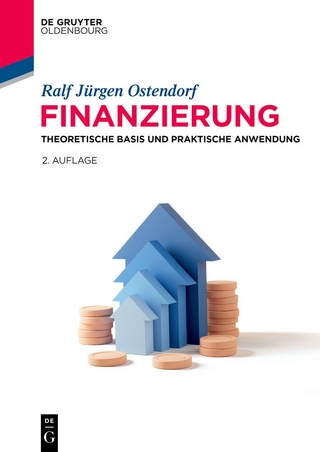
Multinational Financial Management
John Wiley & Sons Inc (Verlag)
978-0-470-41501-6 (ISBN)
- Titel erscheint in neuer Auflage
- Artikel merken
As more businesses in today’s economy are moving towards a global reach, it is essential for finance students to understand how the fundamentals of corporate finance relate to multinational firms. Shapiro’s Multinational Financial Management 9th Edition provides that conceptual framework within which key financial decisions of a multinational firm can be analyzed. The author’s comprehensive approach is to treat international financial management as a natural extension of the principles learned in the first course in financial management. The book builds its coverage of international finance on the framework of valuation established by domestic corporate finance. It can be used in courses in International Financial Management and International Finance at the upper-level undergraduate or MBA level.
Dr. Alan C. Shapiro is the Ivadelle and Theodore Johnson Professor of Banking and Finance. Prior to joining USC in 1978, he was an Assistant Professor at the Wharton School of the University of Pennsylvania (1971-1978). He has also been a Visiting Professor at Yale University, UCLA, the Stockholm School of Economics, University of British Columbia, and the U.S. Naval Academy. His specialties are corporate and international financial management.
PREFACE III
Part I Environment of International Financial Management 1
1 INTRODUCTION: MULTINATIONAL ENTERPRISE AND MULTINATIONAL FINANCIAL MANAGEMENT 2
Learning Objectives 2
Key Terms 2
1.1 The Rise of the Multinational Corporation 4
1.2 The Internationalization of Business and Finance 26
1.3 Multinational Financial Management: Theory and Practice 42
1.4 Outline of the Book 49
Questions 51
Web Resources 51
Web Exercises 52
Appendix 1A: The Origins and Consequences of International Trade 53
The Gains from Trade 53
Specialized Factors of Production 54
Monetary Prices and Exchange Rates 55
Tariffs 55
Questions 56
2 THE DETERMINATION OF EXCHANGE RATES 57
Learning Objectives 57
Key Terms 57
2.1 Setting the Equilibrium Spot Exchange Rate 58
2.2 Expectations and the Asset Market Model of Exchange Rates 65
2.3 The Fundamentals of Central Bank Intervention 82
2.4 The Equilibrium Approach to Exchange Rates 91
2.5 Summary and Conclusions 95
Questions 95
Problems 97
Web Resources 97
Web Exercises 98
Bibliography 98
3 THE INTERNATIONAL MONETARY SYSTEM 99
Learning Objectives 99
Key Terms 99
3.1 Alternative Exchange Rate Systems 100
3.2 A Brief History of the International Monetary System 105
3.3 The European Monetary System and Monetary Union 121
3.4 Emerging Market Currency Crises 135
3.5 Summary and Conclusions 138
Questions 139
Problems 140
Web Resources 141
Web Exercises 141
Bibliography 141
4 PARITY CONDITIONS IN INTERNATIONAL FINANCE AND CURRENCY FORECASTING 142
Learning Objectives 142
Key Terms 142
4.1 Arbitrage and the Law of One Price 143
4.2 Purchasing Power Parity 147
4.3 The Fisher Effect 158
4.4 The International Fisher Effect 166
4.5 Interest Rate Parity Theory 169
4.6 The Relationship Between the Forward Rate and the Future Spot Rate 175
4.7 Currency Forecasting 179
4.8 Summary and Conclusions 186
Questions 188
Problems 189
Web Resources 190
Web Exercises 191
Bibliography 191
5 THE BALANCE OF PAYMENTS AND INTERNATIONAL ECONOMIC LINKAGES 193
Learning Objectives 193
Key Terms 193
5.1 Balance-of-Payments Categories 194
5.2 The International Flow of Goods, Services, and Capital 200
5.3 Coping With the Current-Account Deficit 211
5.4 Summary and Conclusions 222
Questions 223
Problems 224
Web Resources 225
Web Exercises 225
6 COUNTRY RISK ANALYSIS 226
Learning Objectives 226
Key Terms 226
6.1 Measuring Political Risk 227
6.2 Economic and Political Factors Underlying Country Risk 239
6.3 Country Risk Analysis in International Banking 256
6.4 Summary and Conclusions 260
Questions 260
Problems 261
Web Resources 262
Web Exercises 262
Bibliography 262
Part II Foreign Exchange and Derivatives Markets 263
7 THE FOREIGN EXCHANGE MARKET 264
Learning Objectives 264
Key Terms 264
7.1 Organization of The Foreign Exchange Market 265
7.2 The Spot Market 273
7.3 The Forward Market 283
7.4 Summary and Conclusions 289
Questions 289
Problems 290
Web Resources 290
Web Exercises 291
Bibliography 291
8 CURRENCY FUTURES AND OPTIONS MARKETS 292
Learning Objectives 292
Key Terms 292
8.1 Futures Contracts 293
8.2 Currency Options 299
8.4 Summary and Conclusions 320
Questions 320
Problems 320
Web Resources 321
Web Exercises 322
Bibliography 322
Appendix 8A: Option Pricing Using Black-Scholes 322
Implied Volatilities 323
Shortcomings of the Black-Scholes Option Pricing Model 324
Problems 325
Appendix 8B: Put-Call Option Interest Rate Parity 325
Problems 327
9 SWAPS AND INTEREST RATE DERIVATIVES 328
Learning Objectives 328
Key Terms 328
9.1 Interest Rate and Currency Swaps 329
9.2 Interest Rate Forwards and Futures 342
9.3 Structured Notes 346
9.4 Summary and Conclusions 349
Questions 350
Problems 350
Web Resources 351
Web Exercises 352
Bibliography 352
Part III Foreign Exchange Risk Management 353
10 MEASURING AND MANAGING TRANSLATION AND TRANSACTION EXPOSURE 354
Learning Objectives 354
Key Terms 354
10.1 Alternative Measures of Foreign Exchange Exposure 355
10.2 Alternative Currency Translation Methods 357
10.3 Transaction Exposure 359
10.4 Designing a Hedging Strategy 362
10.5 Managing Translation Exposure 372
10.6 Managing Transaction Exposure 374
10.7 Summary and Conclusions 393
Questions 394
Problems 395
Web Resources 397
Web Exercises 398
Bibliography 398
Appendix 10A: Statement of Financial Accounting Standards No. 52 398
Application of FASB No. 52 401
11 MEASURING AND MANAGING ECONOMIC EXPOSURE 403
Learning Objectives 403
Key Terms 403
11.1 Foreign Exchange Risk and Economic Exposure 404
11.2 The Economic Consequences of Exchange Rate Changes 412
11.3 Identifying Economic Exposure 417
11.4 Calculating Economic Exposure 420
11.5 An Operational Measure of Exchange Risk 425
11.6 Managing Operating Exposure 427
11.7 Summary and Conclusions 444
Questions 444
Problems 445
Web Resources 447
Web Exercises 447
Bibliography 448
Part IV Financing the Multinational Corporation 449
12 INTERNATIONAL FINANCING AND NATIONAL CAPITAL MARKETS 450
Learning Objectives 450
Key Terms 450
12.1 Corporate Sources and Uses of Funds 451
12.2 National Capital Markets as International Financial Centers 459
12.3 Development Banks 477
12.4 Project Finance 482
12.5 Summary and Conclusions 483
Questions 484
Problems 484
Web Resources 484
Web Exercises 485
Bibliography 485
13 THE EUROMARKETS 486
Learning Objectives 486
Key Terms 486
13.1 The Eurocurrency Market 486
13.2 Eurobonds 494
13.3 Note Issuance Facilities and Euronotes 502
13.4 Euro-Commercial Paper 506
13.5 The Asiacurrency Market 508
13.6 Summary and Conclusions 509
Questions 509
Problems 509
Web Resources 510
Web Exercises 510
Bibliography 510
14 THE COST OF CAPITAL FOR FOREIGN INVESTMENTS 511
Learning Objectives 511
Key Terms 511
14.1 The Cost of Equity Capital 512
14.2 The Weighted Average Cost of Capital for Foreign Projects 513
14.3 Discount Rates for Foreign Investments 515
14.4 The Cost of Debt Capital 526
14.5 Establishing a Worldwide Capital Structure 528
14.6 Valuing Low-Cost Financing Opportunities 535
14.7 Summary and Conclusions 541
Questions 542
Problems 543
Web Resources 544
Web Exercises 544
Bibliography 544
Part V Foreign Investment Analysis 547
15 INTERNATIONAL PORTFOLIO INVESTMENT 548
Learning Objectives 548
Key Terms 548
15.1 The Risks and Benefits of International Equity Investing 549
15.2 International Bond Investing 569
15.3 Optimal International Asset Allocation 569
15.4 Measuring the Total Return from Foreign Portfolio Investing 570
15.5 Measuring Exchange Risk on Foreign Securities 572
15.6 Summary and Conclusions 574
Questions 574
Problems 575
Web Resources 576
Web Exercises 576
Bibliography 577
16 CORPORATE STRATEGY AND FOREIGN DIRECT INVESTMENT 578
Learning Objectives 578
Key Terms 578
Product and Factor Market Imperfections 579
Financial Market Imperfections 580
16.1 Theory of the Multinational Corporation 579
16.2 The Strategy of Multinational Enterprise 581
16.3 Designing a Global Expansion Strategy 591
16.4 Summary and Conclusions 595
Questions 596
Problems 597
Web Resources 597
Web Exercises 598
Bibliography 598
17 CAPITAL BUDGETING FOR THEMULTINATIONAL CORPORATION 599
Learning Objectives 599
Key Terms 599
17.1 Basics of Capital Budgeting 600
17.2 Issues in Foreign Investment Analysis 607
17.3 Foreign Project Appraisal: The Case of International Diesel Corporation 611
17.4 Political Risk Analysis 621
17.5 Growth Options and Project Evaluation 623
17.6 Summary and Conclusions 627
Questions 627
Problems 628
Web Resources 629
Web Exercises 629
Bibliography 629
Appendix 17A: Managing Political Risk 629
Preinvestment Planning 630
Operating Policies 631
Part VI Multinational Working Capital Management 635
18 FINANCING FOREIGN TRADE 636
Learning Objectives 636
Key Terms 636
18.1 Payment Terms in International Trade 637
18.2 Documents in International Trade 648
18.3 Financing Techniques in International Trade 650
18.4 Government Sources of Export Financing and Credit Insurance 654
18.5 Countertrade 660
18.6 Summary and Conclusions 663
Questions 664
Problems 664
Web Resources 665
Web Exercises 665
Bibliography 665
19 CURRENT ASSET MANAGEMENT AND SHORT-TERM FINANCING 666
Learning Objectives 666
Key Terms 666
19.1 International Cash Management 667
19.2 Accounts Receivable Management 683
19.3 Inventory Management 684
19.4 Short-Term Financing 686
19.5 Summary and Conclusions 697
Questions 698
Problems 699
Web Resources 700
Web Exercises 700
Bibliography 700
20 MANAGING THE MULTINATIONAL FINANCIAL SYSTEM 701
Learning Objectives 701
Key Terms 701
20.1 The Value of the Multinational Financial System 702
20.2 Intercompany Fund-Flow Mechanisms: Costs and Benefits 706
20.3 Designing a Global Remittance Policy 726
20.4 Summary and Conclusions 730
Questions 731
Problems 731
Web Resources 732
Web Exercises 732
Bibliography 733
GLOSSARY 735
INDEX 751
| Erscheint lt. Verlag | 25.3.2009 |
|---|---|
| Verlagsort | New York |
| Sprache | englisch |
| Maße | 197 x 229 mm |
| Gewicht | 1264 g |
| Themenwelt | Wirtschaft ► Betriebswirtschaft / Management ► Finanzierung |
| ISBN-10 | 0-470-41501-0 / 0470415010 |
| ISBN-13 | 978-0-470-41501-6 / 9780470415016 |
| Zustand | Neuware |
| Informationen gemäß Produktsicherheitsverordnung (GPSR) | |
| Haben Sie eine Frage zum Produkt? |
aus dem Bereich



